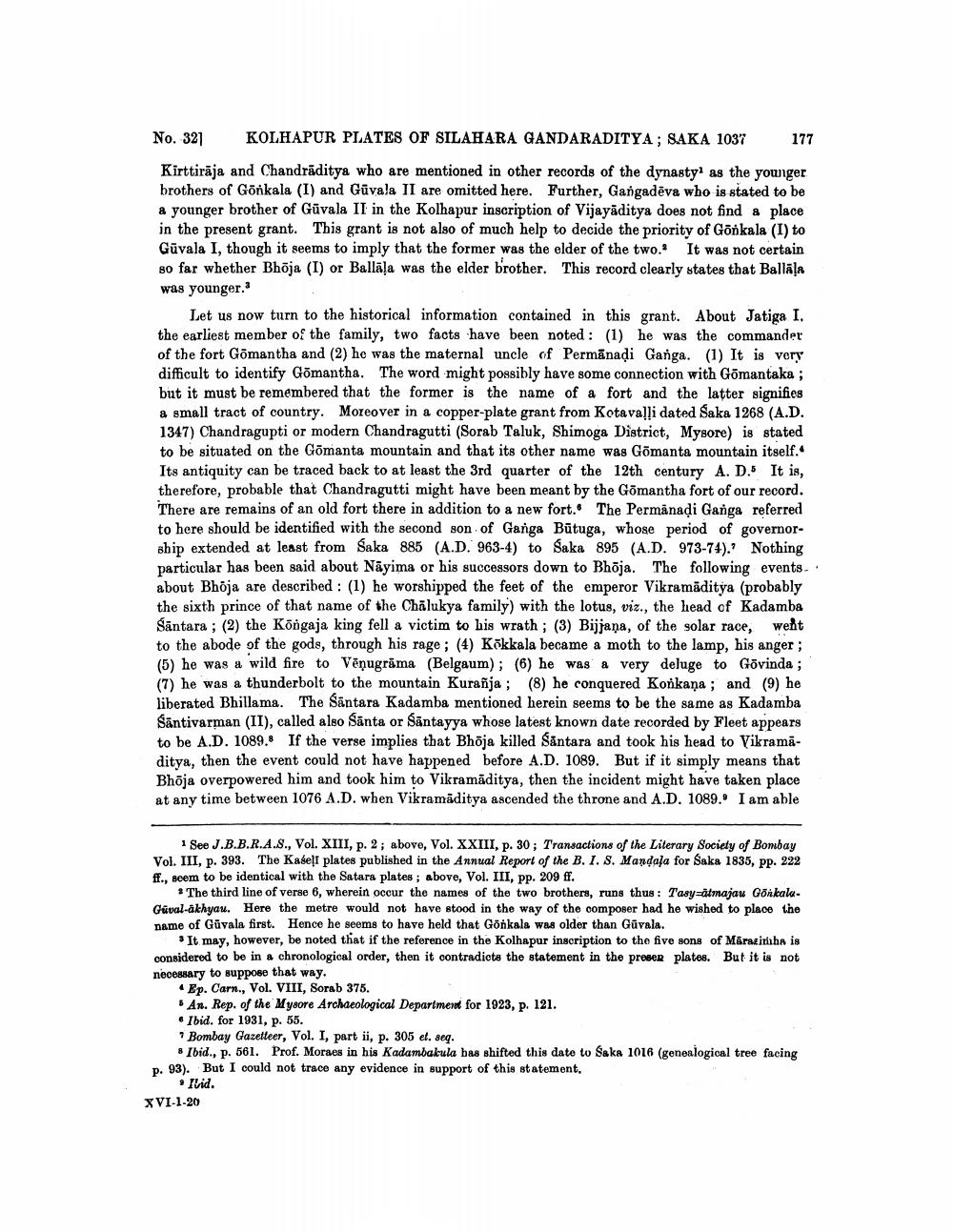________________
No. 321
KOLHAPUR PLATES OF SILAHARA GANDARADITYA; SAKA 1037
Kirttiraja and Chandraditya who are mentioned in other records of the dynasty as the younger brothers of Gōnkala (I) and Gūvala II are omitted here. Further, Gangadeva who is stated to be a younger brother of Guvala II in the Kolhapur inscription of Vijayaditya does not find a place in the present grant. This grant is not also of much help to decide the priority of Gōnkala (I) to Guvala I, though it seems to imply that the former was the elder of the two. It was not certain so far whether Bhōja (I) or Ballāļa was the elder brother. This record clearly states that Ballāļa was younger.3
Let us now turn to the historical information contained in this grant. About Jatiga I. the earliest member of the family, two facts have been noted: (1) he was the commander of the fort Gōmantha and (2) he was the maternal uncle of Permanaḍi Ganga. (1) It is very difficult to identify Gōmantha. The word might possibly have some connection with Gōmantaka; but it must be remembered that the former is the name of a fort and the latter signifies a small tract of country. Moreover in a copper-plate grant from Kotavalli dated Saka 1268 (A.D. 1347) Chandragupti or modern Chandragutti (Sorab Taluk, Shimoga District, Mysore) is stated to be situated on the Gomanta mountain and that its other name was Gōmanta mountain itself. Its antiquity can be traced back to at least the 3rd quarter of the 12th century A. D.5 It is, therefore, probable that Chandragutti might have been meant by the Gōmantha fort of our record. There are remains of an old fort there in addition to a new fort. The Permanaḍi Ganga referred to here should be identified with the second son of Ganga Būtuga, whose period of governorship extended at least from Saka 885 (A.D. 963-4) to Saka 895 (A.D. 973-74). Nothing particular has been said about Nayima or his successors down to Bhoja. The following events. about Bhoja are described: (1) he worshipped the feet of the emperor Vikramaditya (probably the sixth prince of that name of the Chalukya family) with the lotus, viz., the head of Kadamba Santara; (2) the Kōngaja king fell a victim to his wrath; (3) Bijjana, of the solar race, went to the abode of the gods, through his rage; (4) Kokkala became a moth to the lamp, his anger; (5) he was a wild fire to Vēnugrama (Belgaum); (6) he was a very deluge to Govinda; (7) he was a thunderbolt to the mountain Kurañja; (8) he conquered Konkana; and (9) he liberated Bhillama. The Santara Kadamba mentioned herein seems to be the same as Kadamba Santivarman (II), called also Santa or Santayya whose latest known date recorded by Fleet appears to be A.D. 1089. If the verse implies that Bhoja killed Santara and took his head to Vikramaditya, then the event could not have happened before A.D. 1089. But if it simply means that Bhoja overpowered him and took him to Vikramaditya, then the incident might have taken place at any time between 1076 A.D. when Vikramaditya ascended the throne and A.D. 1089. I am able
177
1 See J.B.B.R.A.S., Vol. XIII, p. 2; above, Vol. XXIII, p. 30; Transactions of the Literary Society of Bombay Vol. III, p. 393. The Kaself plates published in the Annual Report of the B. I. S. Mandala for Saka 1835, pp. 222 ff., seem to be identical with the Satara plates; above, Vol. III, pp. 209 ff.
* The third line of verse 6, wherein occur the names of the two brothers, runs thus: Tasy-atmajau GōnkaluGuval-akhyau. Here the metre would not have stood in the way of the composer had he wished to place the name of Guvala first. Hence he seems to have held that Gönkala was older than Gūvala.
It may, however, be noted that if the reference in the Kolhapur inscription to the five sons of Marazinha is considered to be in a chronological order, then it contradicts the statement in the presen plates. But it is not necessary to suppose that way.
Ep. Carn., Vol. VIII, Sorab 375.
An. Rep. of the Mysore Archaeological Department for 1923, p. 121.
Ibid. for 1931, p. 55.
Bombay Gazetteer, Vol. I, part ii, p. 305 et. seq.
8 Ibid., p. 561. Prof. Moraes in his Kadambakula has shifted this date to Saka 1016 (genealogical tree facing
p. 93). But I could not trace any evidence in support of this statement.
• Ibid.
XVI-1-20




